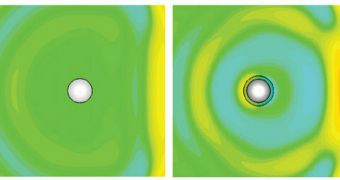In a paper published in the latest issue of the journal Physical Review X, researchers at the University of Texas in Austin (UTA) describe two new methods of addressing a common problem found in modern-day invisibility cloaks. Their solutions could pave the way for employing these materials at a wide scale.
A very common issue with the metamaterials that make up invisibility cloaks is that they are only capable of bending light around the object they are concealing at specific wavelengths. For example, a cloak that works in infrared frequencies is useless when looked upon in visible light.
The metamaterials not only fail to function at wavelengths outside those they were designed to work at, but instead become beacons, making it easier to discover the hidden object. In other words, the combined scattering patterns of the cloaks are more visible across the entire spectrum.
This is a problem because the metamaterials render objects invisible in a certain portion of the spectrum, while highlighting them in others. The research group, led by UTA scientists Andrea Alù and Francesco Monticone, developed two solutions, one active and one passive, to this complex problem.
The passive approach revolves around using very thin shells made out of superconducting materials to conceal the invisibility cloak and its target object. The active method involves tweaking the properties of the metamaterials themselves to reach the desired effect, Physics World reports.
However, not all researchers are convinced that improving invisibility cloaks to the point that they flawlessly redirect light is the best way to go. “I don't think that the paper asks the right question,” says University of St Andrews physicist Ulf Leonhardt.
He argues that the perfect cloaking device may be physically impossible to achieve, and says that this is not the goal physicists should be striving for. An imperfect invisibility cloak, he adds, could prove to be sufficient for any application we may consider in the future.
“If the light takes longer [to pass through a cloak], then this amounts to a big difference that, however, is just an artifact of the analysis. It would tell you that the cloaking device performs rather badly, whereas in reality it works just fine,” Leonhardt says.
He concludes that imperfect invisibility cloaks could still prove extremely useful, since it would take dedicated scientific measurements and expensive equipment simply to figure out that light does not travel to these metamaterials flawlessly.

 14 DAY TRIAL //
14 DAY TRIAL //